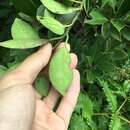Description
(
anglais
)
fourni par eFloras
Trees evergreen, small, ca. 5.5 m tall; bark gray-white. Branchlets brown, robust, longitudinally rugose-plicate; lenticels raised, elliptic; leaf scars slightly raised, subcircular, glabrous; terminal buds ovoid-conical; axillary buds ovoid, glabrous. Petiole 1-1.5 cm, glabrous, abaxially subrounded, rugose, adaxially longitudinally sulcate, distal half narrowly winged by decurrent leaf base; leaf blade abaxially greenish, adaxially deep green, obovate or obovate-elliptic, rarely oblanceolate, 3.5-8 × 1.5-4.5 cm, thickly leathery, both surfaces glabrous, midvein flat or slightly impressed adaxially, lateral veins 6-9 pairs, furcate and anastomosing near margin, raised abaxially, evident or indistinct adaxially, reticulate veins slightly evident abaxially, indistinct adaxially, base cuneate, margin entire, apex obtuse-rounded, with short broad acumen. Inflorescences: cymes, fasciculate, axillary on current year’s branchlets; basal bud scales numerous, ovate, leathery. Male inflorescences: cymes of order 2, 3-flowered; peduncles very short; pedicels 3-5 mm, glabrous; bracteoles 2, subbasal, ovate, 1-1.5 mm, ciliate; flowers 4-merous; calyx patelliform, ca. 3 mm in diam., deeply 4-lobed, lobes ovate, 1-1.5 mm, glabrous, not ciliate; corolla rotate, ca. 7 mm in diam., petals oblong-elliptic, ca. 3.5 × 2 mm; stamens ca. as long as petals, anthers ovoid-oblong; rudimentary ovary subglobose, apex obtuse. Female flowers not known. Infructescences: 1-fruited cymes, fasciculate, fascicles 1-3-fruited; fruiting pedicels 5-10 mm, glabrous; bracts 2, basal. Fruit red, globose, 1-1.2 cm in diam.; persistent calyx explanate, suborbicular, shallowly lobed; lobes orbicular, glabrous, not ciliate; persistent stigma discoid, center retuse, 4-lobed; pyrenes 4, broadly ellipsoidal, ca. 7 mm, ca. 4 mm in diam., abaxially irregularly rugose, pitted, striate, laterally longitudinally striate and pitted, endocarp subwoody. Fl. Apr, fr. Jul-Oct.
- licence
- cc-by-nc-sa-3.0
- droit d’auteur
- Missouri Botanical Garden, 4344 Shaw Boulevard, St. Louis, MO, 63110 USA
Habitat & Distribution
(
anglais
)
fourni par eFloras
Hills along seashores; ca. 200 m to high elevations. Taiwan (Lan Yu), Zhejiang (Putuo) [Japan, Korea].
- licence
- cc-by-nc-sa-3.0
- droit d’auteur
- Missouri Botanical Garden, 4344 Shaw Boulevard, St. Louis, MO, 63110 USA
Synonym
(
anglais
)
fourni par eFloras
Ilex asiatica Sprengel (1824), nom. illeg. superfl., not Lin naeus (1753); ?I. integra var. leucoclada Maximowicz; ?I. leucoclada (Maximowicz) Makino; I. othera Sprengel; Othera japonica Thunberg; Prinos integer Hooker & Arnott; Winterlia integra (Thunberg) K. Koch.
- licence
- cc-by-nc-sa-3.0
- droit d’auteur
- Missouri Botanical Garden, 4344 Shaw Boulevard, St. Louis, MO, 63110 USA
Ilex integra: Brief Summary
(
anglais
)
fourni par wikipedia EN
Ilex integra, the elegance female holly, also called mochi tree, is an ornamental tree of the holly genus, which is native to parts of Asia, including Korea; Taiwan; the mid-southern regions of China; and Honshu, Shikoku and Kyushu in Japan. Its flower is light yellow. The species was botanically described in 1784.
- licence
- cc-by-sa-3.0
- droit d’auteur
- Wikipedia authors and editors

